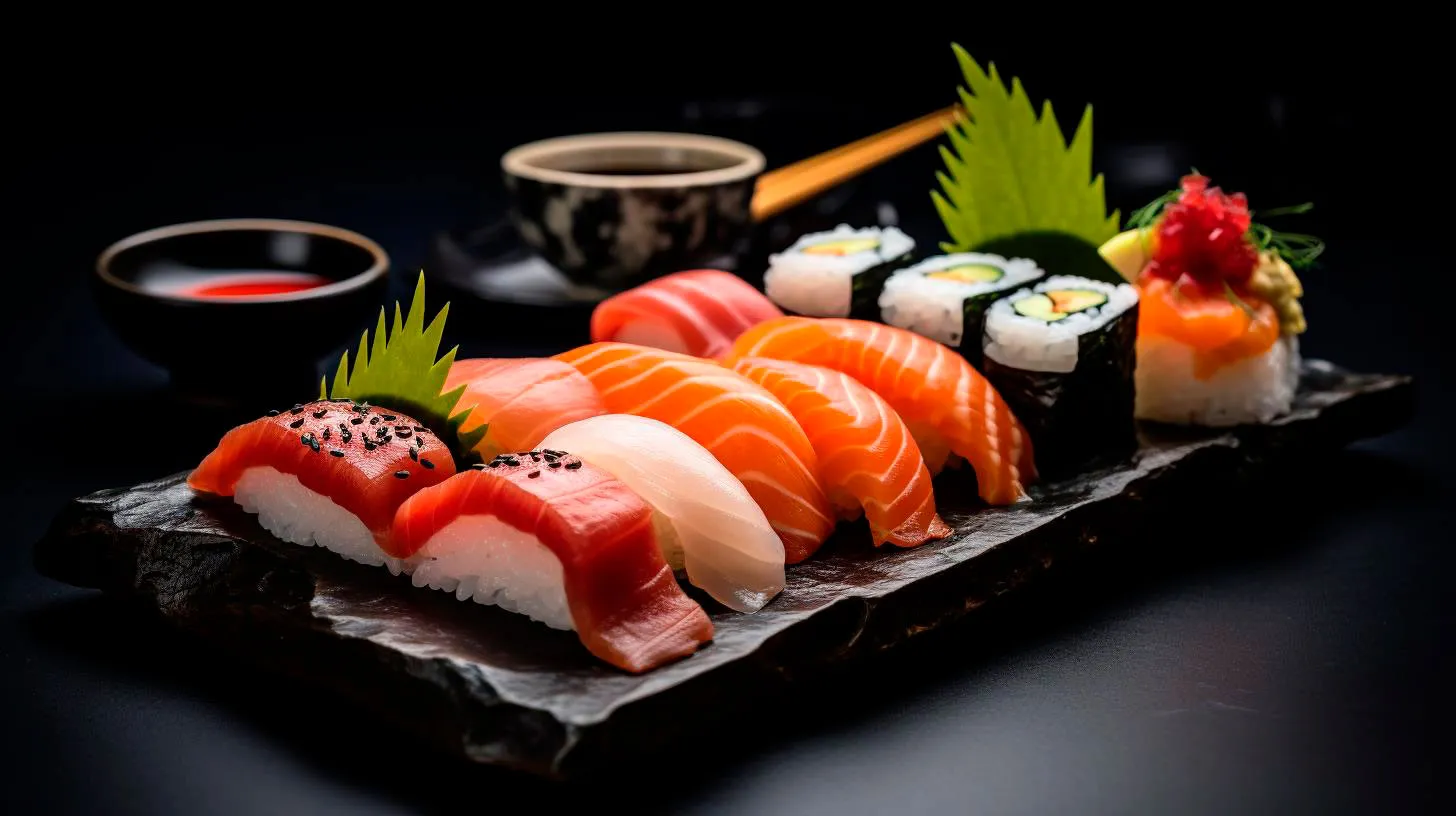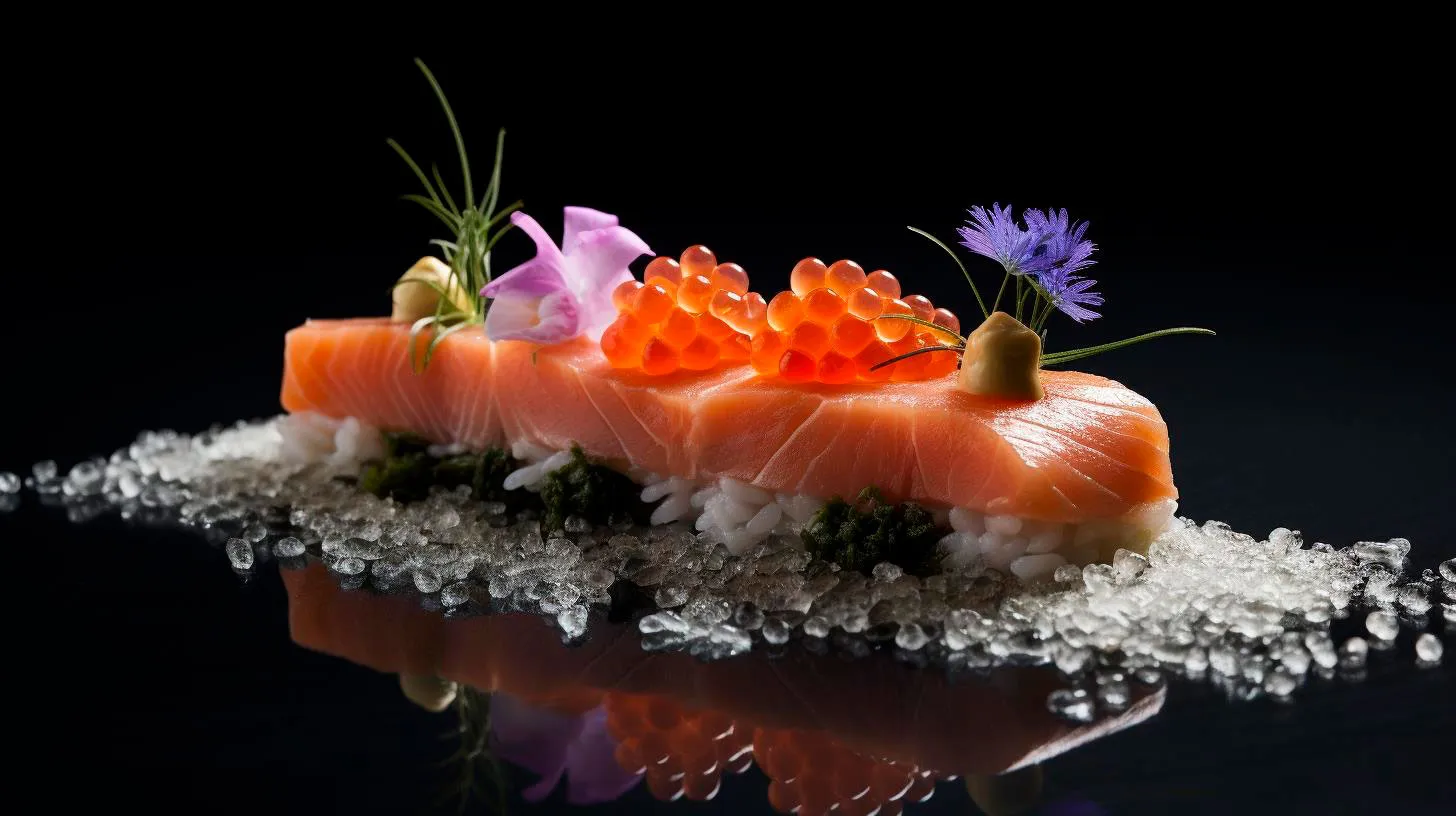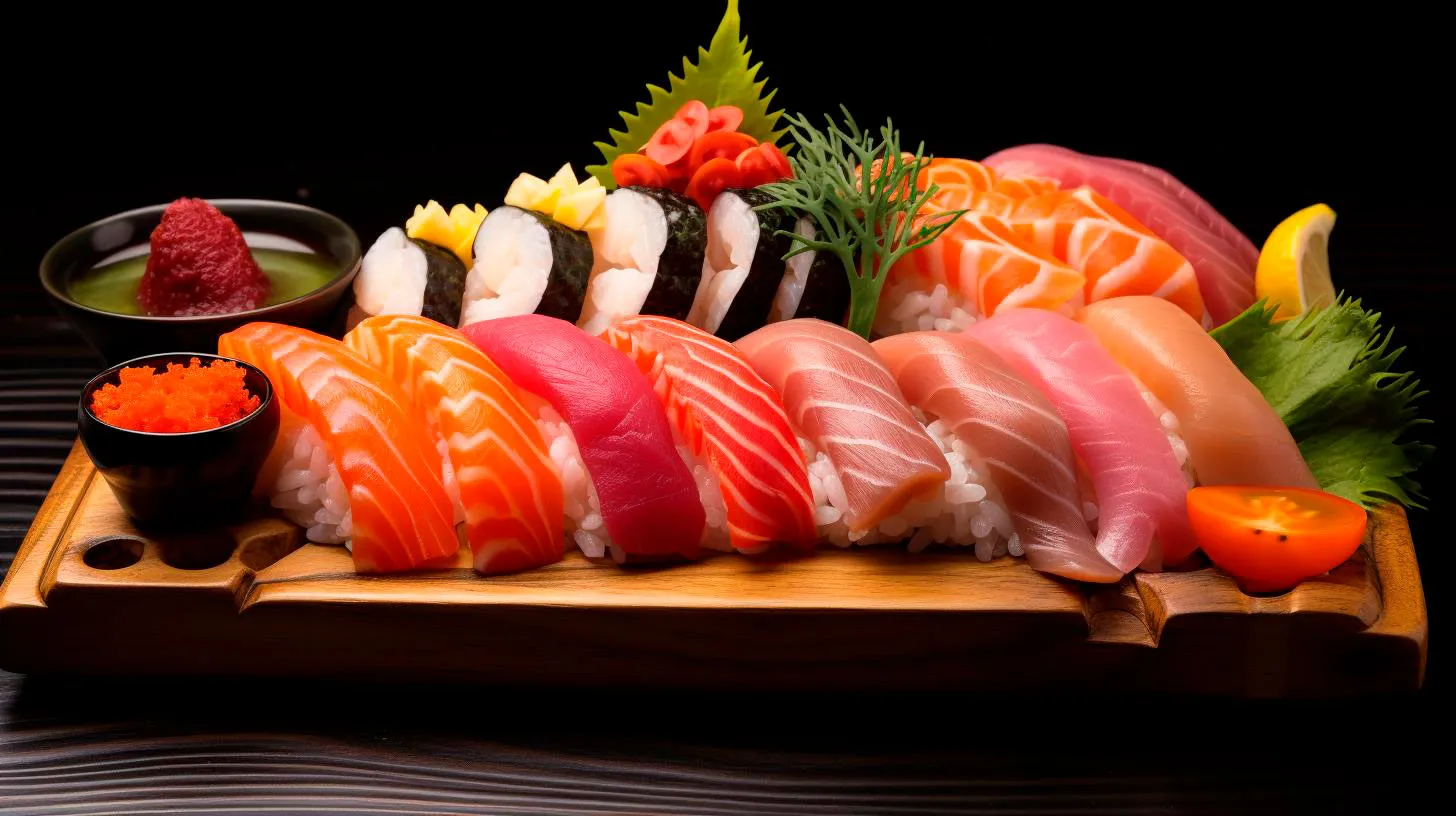Sushi Journey: Unveiling the Art and History of Japan’s Beloved Cuisine
Join us on a flavorsome journey as we explore the art and history behind Japan’s beloved cuisine of sushi. From its humble beginnings to its global popularity, we’ll delve into the secrets of sushi making and its impact on both Japanese culture and the wider culinary world.
The Origins of Sushi
The story of sushi starts around the 8th century in Japan. Originally, sushi was not the delicate rolls or nigiri we know today, but a preservation method for fish. The fish was fermented with rice, salt, and vinegar to preserve it for longer periods. The rice was discarded, and only the fish was consumed.
Over time, sushi evolved. In the 19th century, Hanaya Yohei, a sushi chef from Edo (now Tokyo), revolutionized sushi by serving it with vinegared rice. This innovation made sushi more accessible and enjoyable as a standalone dish. From there, it gained popularity across Japan and eventually around the world.
The Art of Sushi Making
Creating sushi is an intricate process that requires skill, precision, and creativity. Here are some key steps involved in the art of sushi making:
- Preparing the Rice: Sushi rice is the foundation of every sushi dish. The rice is cooked to perfection, seasoned with rice vinegar, sugar, and salt, and then cooled.
- Selection of Ingredients: The sushi chef carefully chooses the freshest fish, seafood, and vegetables to create a harmonious blend of flavors and textures.
- Slicing and Shaping: The chef skillfully slices the fish and shapes the rice into various forms, such as nigiri (hand-pressed) or maki (rolled).
- Adding Accompaniments: Sushi is often accompanied by wasabi (Japanese horseradish), soy sauce, and pickled ginger, which enhance the overall taste.
Each step in the sushi-making process requires attention to detail, expertise, and a deep understanding of flavor balance. It’s a testament to the dedication and craftmanship of sushi chefs worldwide.
The Cultural Significance of Sushi
Sushi is not just a dish; it’s deeply intertwined with Japanese culture. Here are some key aspects that highlight its cultural significance:
- Symbol of Tradition: Sushi represents centuries of tradition and reflects Japanese aesthetics. The minimalist presentation and emphasis on natural flavors embody the principles of simplicity and elegance.
- Seasonality: In Japan, sushi is heavily influenced by seasonal ingredients. Traditional sushi chefs aim to capture the essence of each season by incorporating locally available ingredients.
- Craftsmanship and Mastery: Sushi chefs undergo years of training and apprenticeship to perfect their skills. The pursuit of mastery in the art of sushi making is a testament to Japan’s dedication to craftsmanship.
Sushi has transcended cultural boundaries and has become a global phenomenon. Today, it is enjoyed by millions across the world, and sushi restaurants can be found in nearly every major city.
The Impact of Sushi on Culinary Trends
Sushi’s meteoric rise in popularity has had a significant impact on the culinary world. Here are some key takeaways on its influence:
- Sushi Fusion: The global popularity of sushi has led to the emergence of sushi fusion cuisine. Chefs are blending traditional sushi with flavors and ingredients from other cultural cuisines, resulting in innovative and unique creations.
- Health Consciousness: Sushi’s emphasis on fresh, raw ingredients and balanced flavors has made it a top choice for health-conscious individuals. It offers a nutritious alternative to heavy, calorie-laden meals.
- Enhanced Culinary Appreciation: Sushi has educated palates worldwide, encouraging people to appreciate subtle flavors, textures, and the artistry behind each dish. It has sparked a greater interest in exploring diverse and authentic culinary experiences.
According to a recent industry report, the global sushi market is projected to reach a value of $22 billion by 2027, showcasing its increasing popularity and demand.
Conclusion
Sushi is not just a meal; it’s a journey into the heart of Japanese culture, craftsmanship, and culinary excellence. Its evolution from a preservation method to an international delicacy has captivated taste buds across the globe. Sushi’s cultural significance, meticulous artistry, and impact on culinary trends make it a topic worth exploring.
So next time you savor a delectable piece of sushi, remember the centuries of history and craftsmanship behind it. Indulge in this iconic Japanese cuisine and embark on your own sushi journey.
Food Festivals: Indulge in Culinary Delights from Around the World
In this article, we’ll explore the enticing world of food festivals and highlight some of the most renowned events that showcase global gastronomy.
The Rise of Food Festivals
In recent years, food festivals have exploded in popularity, attracting both locals and tourists alike. According to a survey conducted by the International Food, Wine, and Travel Writers Association, around 96% of respondents said they attended food festivals for the chance to savor unique culinary experiences. Furthermore, the National Restaurant Association reported that 79% of adults in the United States actively seek out food festivals as a form of entertainment.
So what exactly is fueling this surge in food festival popularity? Here are some key factors contributing to its rise:
- Celebration of Local Culture: Food festivals often showcase the unique flavors and traditions of a particular region. They provide an avenue for local chefs and culinary artisans to exhibit their skills and offer a taste of their cultural heritage.
- Social Media Influence: In the age of social media, attending food festivals has become a trendy and share-worthy experience. Visitors often document their culinary adventures through captivating photos and videos, instantly sharing them with their online communities.
- Experiential Marketing: Food festivals offer an excellent platform for food brands to engage directly with consumers. They can conduct tasting sessions, introduce new products, and create memorable experiences that leave a lasting impression.
Must-Visit Food Festivals
Now that we understand the allure of food festivals, let’s delve into some of the top events around the world that deserve a spot on every food enthusiast’s bucket list:
1. Taste of Chicago – Chicago, USA (Statistics)
Taste of Chicago is the largest food festival in the United States, attracting over 1.6 million visitors annually. This iconic event celebrates the city’s diverse culinary scene, featuring dishes from over 40 top local restaurants. Key features and statistics include:
- Dates: Held annually in July
- Participating Restaurants: Over 40
- Menu Items: More than 300
- Attendance: Over 1.6 million visitors
- Key Takeaway: Experience the rich flavors of Chicago’s renowned restaurant scene in one central location.
2. La Tomatina – Buñol, Spain (Statistics)
If you’re looking for a truly unique food festival, La Tomatina in Spain should be on your radar. This annual tomato-throwing extravaganza attracts thousands of eager participants from around the world. Key features and statistics include:
- Date: Held on the last Wednesday of August
- Participants: Over 22,000 (foreign and local)
- Tomatoes Used: Approximately 160 tons
- Key Takeaway: Immerse yourself in a one-of-a-kind cultural spectacle as you join the tomato fight of a lifetime.
3. Oktoberfest – Munich, Germany (Statistics)
Oktoberfest, the world’s largest beer festival, is also a paradise for food lovers. This sixteen-day extravaganza in Munich, Germany, serves up mouthwatering traditional Bavarian delicacies alongside copious amounts of beer. Key features and statistics include:
- Dates: Mid to late September until the first Sunday in October
- Total Visitors: Over 6 million
- Beer Consumed: Approximately 7.5 million liters
- Food Delights: Sausages, pretzels, schnitzel, and more
- Key Takeaway: Experience the vibrant atmosphere of Oktoberfest while indulging in traditional Bavarian cuisine and world-famous beer.
Conclusion
Food festivals offer a captivating blend of culinary delights, cultural experiences, and social engagements. These events not only tantalize our taste buds but also provide an opportunity to explore the diverse flavors our world has to offer. Whether you’re attending a local festival or embarking on a foodie adventure across borders, food festivals are the perfect platform for expanding your gastronomic horizons. So go ahead, plan your next food festival adventure, and savor the delectable delights that await!
Exploring Global Treasures: Discovering Hidden Gems of Cultural Cuisine
While popular dishes like pizza, sushi, or tacos have gained global recognition, there are countless hidden gems of cultural cuisine waiting to be explored. In this article, we’ll dive into the world of gastronomy and explore some lesser-known culinary delights that are worth seeking out during your travels.
Indulge in the Unique Flavors of Pão de Queijo in Brazil
When it comes to culinary treasures, Brazil never fails to disappoint. Among the many mouthwatering dishes, Pão de Queijo stands out as an irresistible treat. These savory cheese bread balls, made from a blend of cassava flour, cheese, eggs, and milk, have a crispy exterior and a delightfully chewy interior. Pão de Queijo is a staple in Brazilian households, often enjoyed as a breakfast item or as a snack throughout the day. These gluten-free delights are perfect for anyone with dietary restrictions, making them a versatile option for everyone.
- Pão de Queijo is a gluten-free delicacy, suitable for individuals with dietary restrictions.
- The blend of cassava flour and cheese gives it a unique and addictive flavor.
- These bite-sized treats can be enjoyed any time of the day as a snack or part of a meal.
Uncover the Hidden Secrets of Laotian Cuisine with Khao Soi
While often overshadowed by its Southeast Asian neighbors, Laos has a culinary scene that is not to be missed. One dish that stands out is Khao Soi, a rich and fragrant curry noodle soup. Khao Soi is typically made with a combination of egg noodles, coconut milk, and a flavorful curry paste made from a blend of spices and herbs. Often topped with crispy fried noodles and served with lime wedges, pickled cabbage, and red onions, Khao Soi offers a texture and taste experience like no other.
- Khao Soi is a fragrant curry noodle soup, packed with complex flavors.
- The combination of egg noodles and coconut milk creates a creamy and satisfying base.
- Crunchy toppings and tangy condiments add layers of textures and taste.
Delight Your Senses with Injera, the Ethiopian Staple
Ethiopian cuisine has a unique character that has captivated food lovers worldwide. At the heart of Ethiopian meals lies injera, a sourdough flatbread that serves as a foundation for a variety of stews and dishes. Made from fermented teff flour, injera has a spongy texture and a slightly tangy taste. Traditionally eaten with the hands, injera not only enhances the flavors of the accompanying dishes but also promotes a sense of community and togetherness during mealtime.
- Injera is a sourdough flatbread made from teff flour, rich in nutrients and gluten-free.
- The spongy texture and tangy flavor complement the various stews and dishes it accompanies.
- Sharing a meal with injera fosters a sense of community and tradition.
Experience the Charms of Thieboudienne, Senegal’s National Dish
When exploring West African cuisine, one dish that stands out is Thieboudienne. Considered Senegal’s national dish, Thieboudienne is a flavorful and aromatic rice and fish stew. Made with a combination of local ingredients such as rice, fish, vegetables, and spices like garlic, onion, and parsley, Thieboudienne offers a symphony of flavors. Often served with a side of steamed vegetables and a fiery pepper sauce, Thieboudienne is a celebration of Senegal’s vibrant culinary heritage.
- Thieboudienne is a hearty rice and fish stew, representing Senegal’s culinary identity.
- The combination of local ingredients and spices creates a burst of flavorful complexity.
- Accompanied by steamed vegetables and pepper sauce, Thieboudienne offers a well-rounded meal.
Conclusion
Exploring the global treasures of cultural cuisine is a thrilling adventure that allows us to delve into different traditions and flavors. From the cheesy delights of Brazil’s Pão de Queijo to the aromatic richness of Laos’ Khao Soi, from Ethiopia’s communal injera to the vibrant flavors of Senegal’s Thieboudienne, each culinary gem offers a unique experience. So, the next time you embark on a journey, be sure to seek out these hidden treasures to expand your gastronomic horizons!
Taste the World: An Epicurean Adventure through International Food Festivals
From iconic dishes to lesser-known delicacies, these events offer a sensory journey that immerses you in the unique flavors and aromas of different regions. If you are a food enthusiast seeking an epicurean adventure, then buckle up and join us as we explore some of the most remarkable international food festivals around the world.
Gastronomic Global Gatherings
1. La Tomatina, Buñol, Spain:
- A tomato fight festival held each year in Buñol, Spain.
- Over 150,000 kilograms of tomatoes are thrown during the event.
- Experience the joy of getting messy with ripe tomatoes while enjoying the vibrant atmosphere.
2. Waikiki Spam Jam, Hawaii, USA:
- Celebrates the love for Spam, a canned meat product highly popular in Hawaii.
- Features live entertainment, food vendors serving creative Spam dishes, and cultural performances.
- Join the festivities and try unique Spam creations like sushi, burgers, and even ice cream!
3. Oktoberfest, Munich, Germany:
- The world’s largest beer festival, attracting over 6 million people annually.
- Indulge in traditional Bavarian food such as pretzels, sausages, and sauerkraut.
- Enjoy music, parades, and of course, the unmatched ambiance of German Gemütlichkeit.
An Enthralling Exploration for the Senses
1. Pizzafest, Naples, Italy:
- Home of the legendary Neapolitan pizza, Naples hosts an annual celebration of this iconic dish.
- Sample a variety of mouthwatering pizzas made with fresh ingredients and cooked in traditional wood-fired ovens.
- Immerse yourself in the birthplace of pizza and experience the passion behind this worldwide favorite.
2. Winterlude, Ottawa, Canada:
- A winter festival where you can dive into the world of delicious maple syrup treats.
- Savor classics like maple taffy and maple-infused pastries.
- Enjoy outdoor activities and admire stunning ice sculptures while indulging in sweet Canadian delights.
Key Takeaways for the Epicurious Traveler
1. Cultural Immersion:
- Food festivals provide an excellent opportunity to immerse yourself in the local culture and traditions of a region.
- Experience authentic flavors while discovering the history and stories behind each dish.
2. Culinary Diversity:
- Explore a wide array of cuisine types, from street food to refined delicacies.
- Discover lesser-known dishes that may become your new favorites.
3. Unforgettable Experiences:
- Food festivals create memories that last a lifetime.
- Meet like-minded food enthusiasts and create friendships over shared culinary experiences.
4. Inspirational Creativity:
- Witness the imaginative use of ingredients and unique cooking techniques through innovative dishes.
- Get inspired to experiment in your own kitchen and incorporate new flavors into your cooking repertoire.
5. Social Connection:
- Food has always been a way to bring people together.
- Share meals, stories, and laughter with locals and other travelers, fostering connections and creating lifelong memories.
In conclusion, embarking on an epicurean adventure through international food festivals will allow you to tantalize your taste buds, broaden your culinary horizons, and create unforgettable memories. Whether you’re reveling in the chaos of La Tomatina or savoring the delicate flavors of Neapolitan pizza, these festivals beckon food enthusiasts from around the globe. So, put on your culinary explorer hat and get ready to taste the world!


